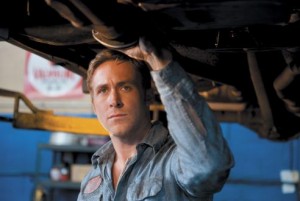 I don’t take notes during movies. (Like I could read them anyway with my handwriting.) I used to take them in a small notebook afterwards, but I evolved with the times and now, after churning them around in my mind for awhile, I record them in a Sticky as soon as I get home to my Mac. This is what was rattling around my head regarding three new movies. Feel free to add your own impressions.
I don’t take notes during movies. (Like I could read them anyway with my handwriting.) I used to take them in a small notebook afterwards, but I evolved with the times and now, after churning them around in my mind for awhile, I record them in a Sticky as soon as I get home to my Mac. This is what was rattling around my head regarding three new movies. Feel free to add your own impressions.
Moneyball is the No. 1 new film, which is highly embarrassing to advertise when the No. 1 movie is actually a 3D reissue of The Lion King.
1) Most sports movies are as rowdy as a tailgate. Moneyball is hushed, and watching it is like visiting a mission in the San Francisco area. Everyone in the audience is respectful–They’re doing math up there! Crunching numbers, not heads! Quiet everybody! I was annoyed as all hell that a guy brought a baby in an Ergo carrier into my show, but the tot soon drifted off into sleep, lulled by Mychael Danna’s score and the overall tone of the piece.
2) Which is not to say that it’s boring. A movie was found within Michael Lewis’ bestseller (a movie that never mentions the term “sabermetrics”) and extracted with precision, humor, heart (albeit mostly when players are being cut from the Oakland A’s as saber-whatever is being applied to show that a little-money team can win in the big leagues) and a certain muted excitement.
3) Moneyball has been called a warmer equivalent to The Social Network, sharing with it a studio (Sony) and a writer (Aaron Sorkin, heavy-hitting with fellow A-lister Steven Zaillian). But the comparison runs deeper. As I tweeted on Tuesday, both are about how computerization has upended our lives, with the old gods of gut instinct and hunches to create a winning team striking out in Moneyball, replaced by statistics and bean counting. Not long ago this would have been the premise for a sports comedy, with the hero bucking the numbers and the computer printouts to put together a winning team of his own seemingly whimsical choosing. In this real-life scenario the dauntless general manager (Brad Pitt) is the numbers guy, assembling an “island of misfit toys” that fit together better than thought and bucking clubhouse tradition with the help of a dweeby statistician (Jonah Hill). The methodology becomes (to quote another Lewis title) the new new thing. The most riveting scenes in the movie show the old guard lashing out against the new, and either getting with the program or getting canned. Not that much warmer than The Social Network.
4) I’m not sure Moneyball is a “sports movie” at all. It’s a sports stats movie, not quite the same thing. Maybe someday a drama will be made from movie boxoffice estimates and totals from Friday to Monday, a game many movie websites that are less interested in movies than in movie statistics play.
 5) Brad Pitt, the Moneyball co-producer, has obvious confidence in Brad Pitt, the Moneyball star. Taking a page from mentor Robert Redford’s book, Pitt allowed director Bennett Miller (Capote) to fill the film with closeups of him thinking, and driving, and thinking some more. And Pitt, past his pretty boy beginnings, makes this intriguing and not fawning, as Redford once did. It’s a beautifully concentrated performance that uncoils when he’s in Hill’s presence.
5) Brad Pitt, the Moneyball co-producer, has obvious confidence in Brad Pitt, the Moneyball star. Taking a page from mentor Robert Redford’s book, Pitt allowed director Bennett Miller (Capote) to fill the film with closeups of him thinking, and driving, and thinking some more. And Pitt, past his pretty boy beginnings, makes this intriguing and not fawning, as Redford once did. It’s a beautifully concentrated performance that uncoils when he’s in Hill’s presence.
6) Third-act complication. When Philip Seymour Hoffman, as disbelieving A’s manager Art Howe, is given credit for the team’s record-setting turnaround Hill’s character balks. We expect some sort of confrontation, but Hoffman just recedes from the movie at that point. Strange.
7) The Lenka earwig “The Show” is very effectively used, twice. First, to show Pitt’s affection and concern for his daughter, who lives with her mom, then, at the end, to give the movie a grace note (lent by the daughter) that Miller (no David Fincher) can’t find visually. So what if the song hit in 2008 and the movie takes place in 2002? Some things are beyond charts and statistics.
Drive is a critics’ darling that stalled with audiences, and the critics are miffed. What went wrong?
1a) The movie (an adaptation of a cult novel) fuses existential-ish 70s ne0-noirs like The Last Run (1970) and The Driver (1978) with stylish, score-soaked 80s films cut from the same cloth, like Michael Mann’s Thief. Critics love those movies. I’m a fan, too. Audiences never took to them.
 1b) The movie cruises along for a time as a tense, romance-flecked, dreamlike crime drama, then switches gears and comes crashing to earth with splattery violence. Audiences hate that.
1b) The movie cruises along for a time as a tense, romance-flecked, dreamlike crime drama, then switches gears and comes crashing to earth with splattery violence. Audiences hate that.
1c) It half-uses the whole scorpion-and-the-frog fable. Again. There’s retro and there’s worn out, and that has whiskers on it.
1d) A movie called Drive must deliver one classic car chase. It must have a Bullitt scene, a French Connection scene, a Grindhouse: Death Proof scene. It does it. The director, Nicolas Winding Refn, half-delivers one or two, smothered in music and stylistics. Good enough to win best director at Cannes, insufficient for thrill seekers.
1e) Ryan Gosling can do no wrong with me. Well, little wrong. He’s fine with the brooding loner aspect of his character, a good fit with Carey Mulligan for a principled, by the code liaison–but just didn’t convince as a bloodsoaked avenger going about his deadly rounds in a stained scorpion jacket that no notices (it’s dreamlike, remember?) I’m OK with the letdown; not every actor has to be a killing machine.
2) With Bryan Cranston and Ron Perlman aboard, however, no letdowns in the supporting cast. Christina Hendricks makes a vivid, fleeting impression.
3) And a gangsta Albert Brooks is awesome as the heavy, always a little remorseful as he cuts to the chase with his associates. A terrific change of pace for the great, perennially underrated comic, who had farther to go given a more established persona than Gosling’s and made it.
4) “I never pictured you as menacing. But I saw Drive and now I’m scared to death.” “Be afraid. Be somewhat afraid.” Brooks on Twitter.
5) Nothing against the fine Cliff Martinez score but I hate that the songs aren’t available to purchase singly on iTunes. The Riz Ortolani composition “Oh My Love,” featuring Katyna Ranieri, is spectacular, and parts of the score almost put the movie across. Almost.
 The Debt is the kind of movie that you go to see when there’s not much playing that you want to see, so you see The Debt.
The Debt is the kind of movie that you go to see when there’s not much playing that you want to see, so you see The Debt.
1) A generic title for a generic thriller with a moral bent. And an ill-fitting one, too. I assume The Debt is to country, as in the 90s aged Mossad agent Helen Mirren has to make good on an assignment she and her cohorts bungled in the 60s. But that’s a little fancy. The Betrayal, maybe? The Lie? Doesn’t matter, they’re all plain wrap.
2) Even Mirren can’t make that last stretch credible, as her grandma swings into improbable action. The inevitable Jessica Chastain plays her younger self.
3) With its Nazi practitioner The Debt could have done for gynecology what Marathon Man did for dentistry. Doesn’t go there, though. Fortunately.
4) The inconsistent John Madden (Shakespeare in Love) made a better thriller, Killshot, that never got a release. Check it out on DVD.
5) I have no other notes on The Debt.





Comments